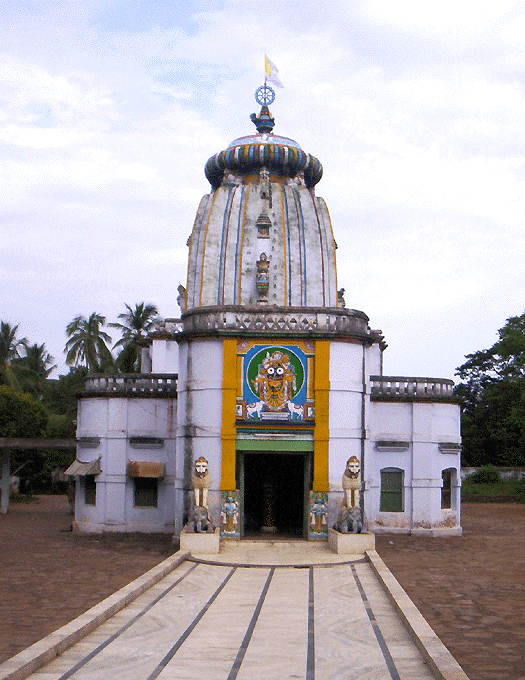Sree Jagannath Jeeu of Nayagarh
BY: GEETA DEVI

Jagannath Temple, Nayagarh
Oct 11, SAKHIGOPAL, PURI
(SUN) — Though the Rajas of Nayagarh were Saivites of the Lakulisa Pasupata Sect, they were equally devoted to the Vaisnavite faiths. Raja Bagha Singh (1480-1510 A.D.), who rose from the status of a petty chieftain of Ralaba to the stature of a Raja Samanta (feudatory chief), created a new Fort (Nuagarh) at the present principality of Nayagarh. He is credited with having made small icons of Shree Vigraha Chaturdha Murty, and installed the Deities in a mud altar on the foothill of Balarama, for the first time in the history of Nayagarh.
During the rule of Raja Ramachandra Singh (1720-30 A.D.), the small icons of the Chaturdha Murty were removed to Sinduria. New icons of comparatively bigger size were constructed and worshipped at Nayagarh, on an altar of black chlorite stone.
It was during the reign of Raja Binayak Singh (1793 - 1823 AD) that the present icons were installed in the newly built temple of Sri Jagannath on the foothill of Balarama. The old images installed by Raja Ramachandra Singh were removed to the temple precinct of Sri Ladu Baba of Sarankul. The stone altar on which the Deities were installed by Raja Ramachandra Singh was sold for a nominal price of Rs.250 in 1890 A.D. to Neela Kothlok of the palace (Kept of the Raja), which was used as the pedestal (padma prusta) of Lord Gopinath Jeeu.
Only the main sanctum (viman), 120 ft. in height, was constructed by Raja Binayak Singh. However, he had kept Rupees 60 (Sixty) thousand along with some building materials for the construction of the frontal porch, or jagamohana. Due to his demise in 1823 A.D., the work could not be completed. His son, Raja Brajabandhu Singh, spent the money otherwise, to purchase the estate of Baramba, which was then being sold on auction to repay back loans. So the frontal porch of the temple of Lord Jagannath could not be built. However, a flat-roofed pucca building was later built to serve the purpose of jagamohana.
The main temple of Lord Jagannath is of a rekha order, characterised by a Pancha Ratha plan. As usual, Varaha, Narasingha and Trivikrama are installed as Parsvadevatas around the main sanctum.
On the lintel of the doorjamb there are stone carvings of the nine planets. Just above the planets there is the carving of Gajalakshmi. It is said that Raja Binayak Singh sought the assistance of Mukunda Mahapatra, a sculptor from the state of Athgarh (Ganjam). Mukunda was the father of the famous poet Jadumani Mahapatra. Mukunda's father, Raghumani Mahapatra, carved out the icon of Radha Ballava for the Raja of Athgarh.
Raghumani's father, Artabandhu Mahapatra, was the main mason to make the icon of Lord Jagannath in the state of Athgarh. In all probability, Raja Binayak Singh, who had a family connection with the Raja of Athgarh, might have invited Mukunda Mahapatra to house the family at Itamati with royal land grants, to use his masonry skill. Mukunda also carved out the image of Lord Radha-mohan Jeeu installed in the palace precinct.
Raja Binayak Singh introduced the Chhatisa Niyog Sevas for the Deities in the line of Lord Jagannath of Puri. He also recorded huge land grants to defray the expenses of the temple. The royats of Sakiri were providing fine rice, measuring sixty-two cart loads of paddy. They were also discharging other bethis (services free of cost) for the temple.
Royats of Itamati were discharging bethis for the Gundicha Bhawan. Royats of Balipatna, Gundi Gadia and Bhalia Padar were discharging the duty of prahari (doorkeeper) on bethi. All the royats were providing vegetables for Dwitiya Osha.
The Car Festival, Makara, Chandan and Snana Yatras are the chief festivals of the Deity. In the line of Lord Jagannath Jeeu of Puri, here also three chariots are used for Rath Yatra. The making of the chariots starts from the day of Akshyaya Tritiya. The Khonds of the state were previously providing the ropes and discharging some other duties on bethi. Nowadays, the Debottar Department assumes all responsibilities for the festival.
On the day of the car festival, the Raja of Nayagarh comes from the old palace in a grand procession and performs the chhera panhara (sacred sweeping) of the chariots with a golden broom. Then only the chariots start their journey to the Adapa Mandapa. In the Adapa Mandapa (Gundicha Ghara) also all rituals like that of Puri are observed with pomp and grandeur. The festival ends with the return journey (Bahuda Yatra). Like the sacred Mahaprasad, here also Anna Prasad (rice, dal, curry, etc.) is available in earthen pots (kudua) to the devotees of the Lord.
